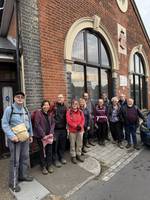Our September trip was to the 1912 Centre in Harwich. The 1912 bit relates to when the building was first built. Following a devastating fire it was decided that Harwich old town needed a dedicated fire station. Ironically it was built on a lot vacated due to fire. Up to 1925 the equipment was horse drawn, although it was hard to see where the horses would have been kept, then engines until it closed in 1985. The building lay abandoned for some years before it was converted to a hostel and welcomed its first guests in 2004. Our first visit was in 2010.
 Ever since that first visit I have wanted to visit the Electric Palace next door. Built in 1911 the Electric Palace is one of the earliest cinemas still operating. When you approach the front there is an old fashioned ticket kiosk with doors either side. One for the shilling seats (posh) and one for the sixpenny seats (where we went). The inside has been beautifully restored since the building was re-discovered in 1972, but still retains some unique features – like an original silent screen behind the modern one. Naturally the film we went to see was a modern one, but it was a pleasure to support such a fantastic old venue.
Ever since that first visit I have wanted to visit the Electric Palace next door. Built in 1911 the Electric Palace is one of the earliest cinemas still operating. When you approach the front there is an old fashioned ticket kiosk with doors either side. One for the shilling seats (posh) and one for the sixpenny seats (where we went). The inside has been beautifully restored since the building was re-discovered in 1972, but still retains some unique features – like an original silent screen behind the modern one. Naturally the film we went to see was a modern one, but it was a pleasure to support such a fantastic old venue.
 By contrast our walk on Saturday took us past an equally decorative, but starkly modern building – Grayson Perry’s “A House for Essex”. We took the train from Harwich to Wrabness and the footpath linking to the Stour estuary went past it. The house was completed in 2015, so we missed it when we did the Essex Way in 2010. This eccentric house features a distinctive exterior with bespoke ceramic tiles, a golden copper alloy roof, and eye-catching sculptures. It is designed to look like a miniature chapel and is intended to explore the history and character of Essex through the life of Julie Cope, a fictitious Essex 'everywoman'.
By contrast our walk on Saturday took us past an equally decorative, but starkly modern building – Grayson Perry’s “A House for Essex”. We took the train from Harwich to Wrabness and the footpath linking to the Stour estuary went past it. The house was completed in 2015, so we missed it when we did the Essex Way in 2010. This eccentric house features a distinctive exterior with bespoke ceramic tiles, a golden copper alloy roof, and eye-catching sculptures. It is designed to look like a miniature chapel and is intended to explore the history and character of Essex through the life of Julie Cope, a fictitious Essex 'everywoman'.
On Sunday we explored four centuries of history on the Harwich Maritime Heritage trail. We learnt about the Harwich-built ship Mayflower which sailed to the New World in 1620, visited the 18th century Guildhall and Custom House, saw the 19th century High and Low Lighthouses, read about the rescued Kindertransport children who arrived in Harwich in 1939, and the tragic story of the 1953 floods. A collection of colourful buoys and lightvessels led us towards the huge modern Trinity House buildings in Harwich which house the operations centre from which all lighthouses in England and Wales are now controlled. And a visit to the Harwich Museum gave us an opportunity to find out all about the history of the train ferries (George’s specialist subject!).
![]() Overlooking Harwich town and in a strategic position over the estuary is a prominence called Beacon Hill. The town has kind of come up to meet it, making it somewhat harder to see why it was first chosen for a fort in Tudor times. Nothing of those first buildings remains as Beacon Hill Fort has been invented and re-invented for defence right up to the cold war. We spent a happy afternoon exploring 30 or so buildings remaining, dating from 1890 to 1956. Big echo-y gun emplacements, underground ammunition stores and a massive observation tower called “The Dolls House” as it used to have doors and windows painted on the side to fool the enemy. Really?
Overlooking Harwich town and in a strategic position over the estuary is a prominence called Beacon Hill. The town has kind of come up to meet it, making it somewhat harder to see why it was first chosen for a fort in Tudor times. Nothing of those first buildings remains as Beacon Hill Fort has been invented and re-invented for defence right up to the cold war. We spent a happy afternoon exploring 30 or so buildings remaining, dating from 1890 to 1956. Big echo-y gun emplacements, underground ammunition stores and a massive observation tower called “The Dolls House” as it used to have doors and windows painted on the side to fool the enemy. Really?
Ali & Dave
